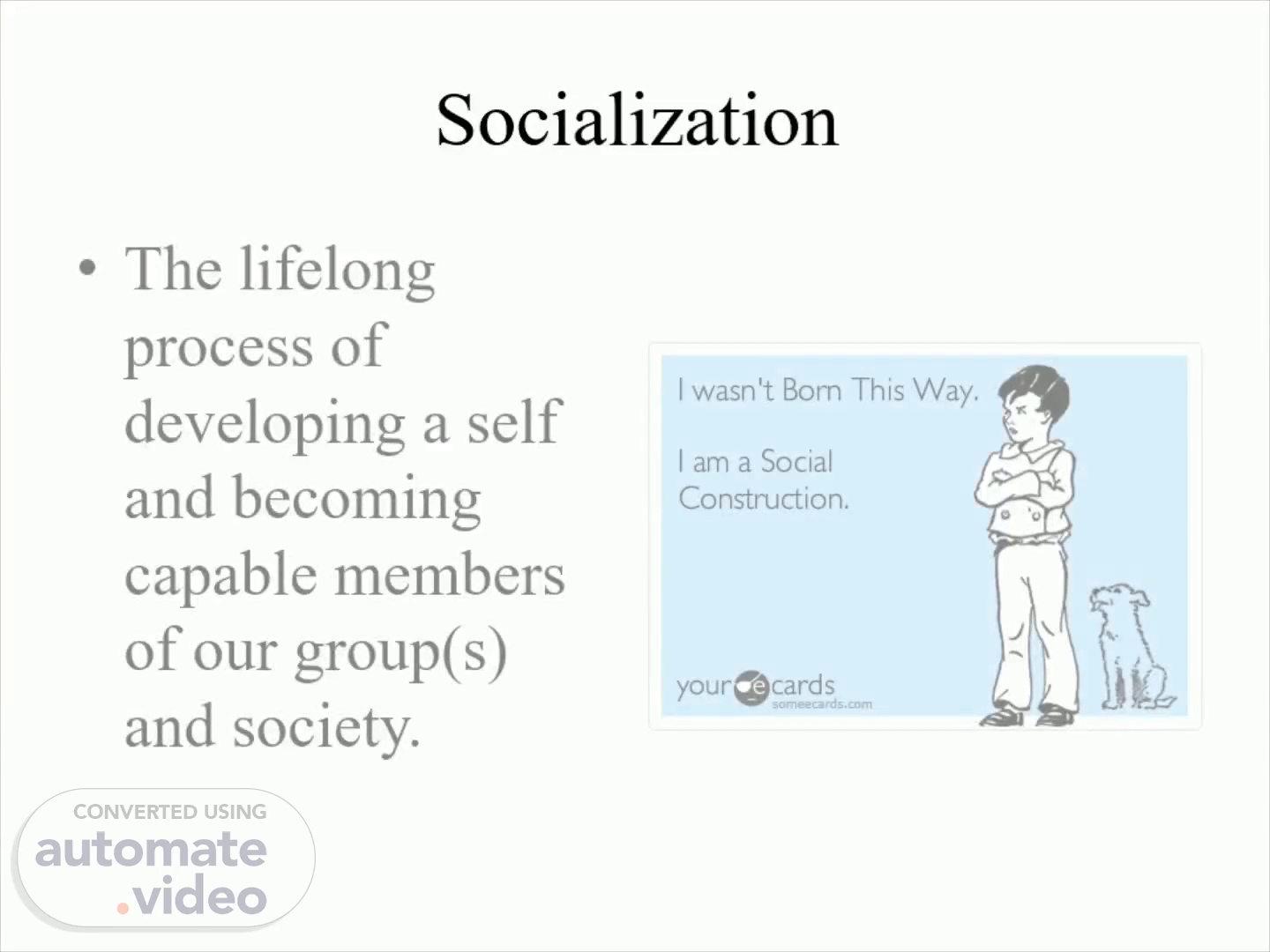Scene 1 (0s)
Socialization. The lifelong process of developing a self and becoming capable members of our group(s) and society..
Scene 2 (9s)
Introduction to the Self and Social Structure Module.
Scene 3 (46s)
Socialization is not a party. Socialization is the process through which we learn how to become ourselves and members of our society. It does NOT mean talking to each other (or “socializing” in the ordinary English sense of the word). We need to learn our language, what counts as food, what we should wear, what we should know, etc. to be a part of our society. So how do we learn this stuff?.
Scene 4 (1m 8s)
Nature vs. Nurture The first debate. The idea of nature is that our biology creates our personalities, choices, etc. In other words, we don’t really get socialized. We don’t learn our society; our bodies determine who we are. The idea of nurture is that our society creates our personalities, choices, etc. Sociologists argue that this dichotomy (two mutually exclusive choices) does not accurately represent human development. While our genes may provide us with specific, individual aptitudes, our culture and environment make it possible or impossible for those aptitudes to be expressed and shape the means of expression. In other words, our personal biography intersects with both social history and our personal biology. Shades of C. Wright Mills! See the next slide .
Scene 5 (1m 42s)
Nature, nurture, and the sociological imagination.
Scene 6 (2m 9s)
Human beings are social animals. Human beings require human interaction in order to develop into fully realized people and to maintain mental health. The process of socialization teaches us how to interact with other people in culturally appropriate ways. There are numerous psychological studies about the negative effects of isolation on human beings. The Geneva Conventions on the Treatment of Prisoners of War and the U.N. Standard Minimum Rules for the Treatment of Prisoners forbids prolonged solitary confinement. Cross-cultural studies show that shunning is often considered the very worst punishment possible. People who are shunned are at an extremely high risk of suicide..
Scene 7 (2m 38s)
Genie-a tragic example of extreme isolation. In 1970, a 13-year-old girl who had been kept in virtual isolation for most of her life was found in California. Her tragedy provided psychologists and linguists with the opportunity to study the effects of isolation on language and social development. These studies occurred in the context of her treatment and provided valuable information about the stunting effects of isolation on the brain. This optional video is an excerpt from a documentary about Genie. http://www.youtube.com/watch?v=VjZolHCrC8E.
Scene 8 (3m 3s)
Primary socialization. Because of her extreme isolation, Genie had no one to socialize her For most of the rest of us, our primary socialization occurs within our family. Primary socialization is the way that we learn the very basic structures of our society such as our language, what things are considered food and how to eat them, and basic gender behaviors. We mostly take what we learn in primary socialization for granted..
Scene 9 (3m 24s)
Agents of socialization. While our families are key agents of our primary socialization, sociologists have identified several other agents who typically provide secondary socialization: school peers mass media work religion the state (our country) Secondary socialization is the way we learn our place in society and the skills necessary to interact beyond our families. Primary socialization mostly happens when we are very small; we don’t even remember it happening. Secondary socialization is the process of learning everything else..
Scene 10 (3m 48s)
Quiz Question 1. While our family typically provides our primary socialization, there are several agents of socialization that move us beyond the basics. The list on the previous slide includes agents of secondary socialization. Pick 4 of these ( except the family ) and write about how each one has helped you to become a member of society..
Scene 11 (4m 5s)
Socialization never stops. As we grow, we continue to become socialized into our new age categories. For example, we expect different knowledge and behaviors from someone who is 5 years old, 15 years old, and 50 years old. When we take on new identities and responsibilities (work, parenting, etc.), we learn the expectations of those identities. Most socialization after our early childhood is secondary socialization, although we may learn about what it means to be an adult from watching our parents when we are very young. There area several different types of socialization. Here, we’ll only discuss three: Anticipatory socialization Resocialization, and Reverse socialization..
Scene 12 (4m 35s)
Types of socialization anticipatory socialization.
Scene 13 (4m 54s)
Types of socialization resocialization. Resocialization happens when there is a change in our lives and we must give up our previous understandings and learn new ones. We must unlearn how to be in society in order to learn the expectations of new statuses. For example, when we move from high school to college, we learn that being a student requires more thought and more time; when we move to a new country, we must learn the new norms of that place..
Scene 14 (5m 16s)
Types of socialization resocialization and total institutions.
Scene 15 (5m 51s)
Types of socialization reverse socialization. Reverse socialization typically happens when the expected order of socialization is reversed—when the child socializes the parent. Reverse socialization often happens in immigrant families, when the child has learned the norms, values, beliefs, and behaviors of the new society and must help to educate their parents..
